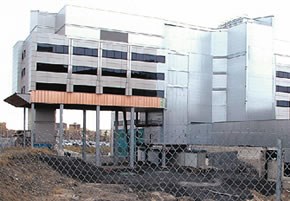BY JANET GIBSON
The North East Local Health Integration Network (LHIN) wants providers of health care in this area to consolidate their functions so that they can better serve their clients.
The North East LHIN plans, funds and co-ordinates health care services for more than half-a-million people across 400,000 sq. km. It manages the health care delivered by hospitals as well as long-term care facilities, community health centres, community support services and mental health agencies.
“The more money they can gain on the administrative side, the more money will be available for the service delivery side,” said LHIN CEO Rémy Beaudoin.
It’s a strategy the LHIN wants Sudbury Regional Hospital to use to get out of the red, hospital CEO Vickie Kaminski told fellow board members on June 10.
“We haven’t done a lot of integration in the northeast,” she said.
Kaminski told the LHIN the hospital will likely have a deficit of $815,000 for the 2008/2009 fiscal year.
By law, hospitals can’t run a deficit and won’t get government funding unless they have a balanced budget, Beaudoin said.
“Sometimes it’s very challenging,” he added.
Hospital board members passed a motion to “develop an integration plan by March 2009, for review by the NE LHIN that will identify services that should be developed, retained and/or enhanced at Sudbury Regional Hospital.”
Further, board members agreed to a hospital service accountability agreement for 2008/2009 that projects a deficit of not more than $2.1 million or a surplus of not less than $406,000.
While the deficit will likely be $815,000, Kaminski said, the hospital has asked for additional funding. Whether there will be a deficit or a surplus depends on how much money the hospital gets.
The Ministry of Health requires the hospitals and LHINs to sign accountability agreements that spell out how much money a hospital will get and the services it will deliver.
Normally, the agreement covers a two-year period. But this year’s agreement for Sudbury Regional Hospital is for one year, during which time it can work on getting into the black.
Kaminski said in an interview the hospital’s deficit can be attributed to factors such as higher salaries, more expensive goods and supplies and the cost of being a teaching hospital.
Another major factor, Beaudoin said, is the number of alternate level of care patients in the hospital. The ALC patients are in beds because they need short-term, intensive treatment for an illness or injury or because they’re recovering from surgery. But afterward they need an alternate level of care the hospital can’t provide. For example, they may need a long-term care home bed, home care or palliative care. On May 29, the hospital was caring for a record number of 121 ALC patients. Two-thirds of them were waiting to be placed in a long-term care home.
This phenomenon means the hospital is always operating at capacity or over-capacity, Beaudoin said, when it should be operating at 85 per cent capacity.
“No one provider can answer all the needs,” Beaudoin said. He wants the hospital and other providers of care to hammer out a plan that says, “If that client comes in to any one of our doors, this is what we’re going to do.”
To learn more, go online to www.nelhin.on.ca.
Join Sudbury.com+
- Messages
- Post a Listing
- Your Listings
- Your Profile
- Your Subscriptions
- Your Likes
- Your Business
- Support Local News
- Payment History
Sudbury.com+ members
Already a +member?
Not a +member?
Sign up for a Sudbury.com+ account for instant access to upcoming contests, local offers, auctions and so much more.
